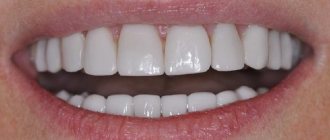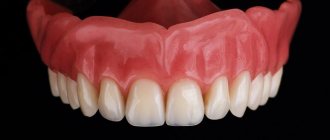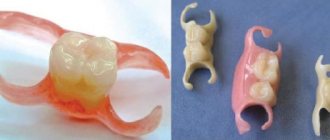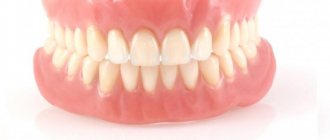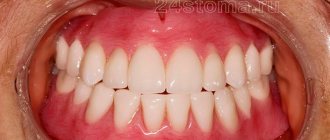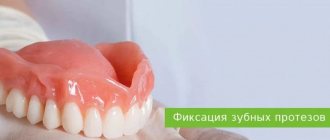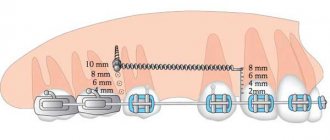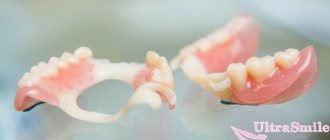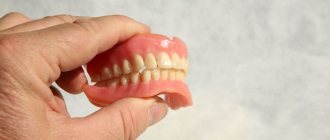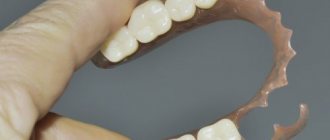Classification of elastic polymers
Elastic polymers are made from different materials:
- acrylic;
- polyvinyl chloride;
- vinyl chloride with butyl acrylate;
- siloxane or silicone;
- fluoroelastomer
Elastic polymers belong to one of two groups - plastics with high or low temperature polymerization. Available in the form of a gel, elastic sheets, a set of powder and liquid, or in the form of a laminated gel or in cartridges. The powder is a copolymer of acrylic monomers.
Molding fluid is a mixture of acrylic monomers or methyl methacrylate containing a plasticizer and some organic solvents. The second option is a liquid made from acrylic monomers - for fast-hardening plastics.
Main base plastics and their properties
Ethacryl (AKR-15) is a base material that is a copolymer of methyl methacrylate, ethyl methacrylate and methyl acrylate, colored in a color similar to that of the oral mucosa. It has increased plasticity at the time of molding and sufficient elasticity after polymerization. Used for removable denture bases, individual impression trays, and phantom jaw models.
The powder (polymer) is plasticized due to internal plasticization by introducing “methacrylate” into the macromolecule. The liquid is a combination of three monomers - methyl methacrylate, ethyl methacrylate and methyl acrylate in a ratio of 89:8:2.
Polymerization of the polymer-monomer composition is carried out, as a rule, in a water bath.
The base material Ftorax is a high-temperature polymerization plastic and belongs to graft copolymers. The material is “grafted” on the basis of acrylic resins from fluorine rubber and compares favorably with other acrylates by its higher physical, mechanical and chemical properties.
Ftorax has a static bending angle that is 20% higher than AKR-15 and 15% higher than Akrel, and the specific impact strength is higher by 9% and 11%, respectively.
It should be noted such properties as slow aging, slight water absorption, preservation or slight change in linear dimensions, lack of toxic effects on the microflora of the oral cavity, as well as on the body as a whole. Here we need to add a shorter adaptation period to prostheses made from Ftorax and a good imitation of the color of the oral mucosa [Kharchenko SV., 1971].
Ftorax powder is a fine, pink-colored, suspension and graft copolymer of methacrylic acid methyl ester and fluorine rubber. The liquid is methacrylic acid methyl ester containing a cross-linking agent - diphenylopropane dimethacrylic ester.
The main disadvantage of Ftorax is the significant content of residual MMA monomer, which, apparently, is the cause of fairly frequent toxic-allergic reactions to this material.
Acronil has increased impact resistance, low water absorption, and good technological performance. The powder is a methyl methacrylate copolymer grafted onto polyvinyl acetal, and the liquid is methyl methacrylate containing a cross-linking agent. Acronil contains an inhibitor and stabilizer.
Acrel is a copolymer with “cross-linked” polymer chains, which gives it increased physical and mechanical properties. The formation of a network (cross-linked) structure of the polymer occurs during the polymerization process with the help of a cross-linking agent, which is introduced into the monomer and participates in the reaction only during the polymerization of the molding mass. Acrela liquid, in addition to methyl methacrylate, contains a cross-linking agent and an inhibitor. The powder consists of fine polymethyl methacrylate plasticized with dibutyl phthalate.
Bakryl is a high-strength acrylic plastic that, compared to other polymers, has greater resistance to cracking, abrasion, impact strength and high bending strength. The powder is polymethyl methacrylate modified with elastomers. The liquid is methyl methacrylate with inhibitors. Plastic has good manufacturability.
Colorless plastic for prosthesis bases is a polymer based on polymethyl methacrylate, free of stabilizer, containing an antiaging agent, and consists of powder and liquid. It differs from other produced base materials in its increased strength and transparency. Technological manipulation of plastic does not differ from the generally accepted ones.
Imported analogues of base plastics supplied to Russia correspond to domestic ones in terms of basic physical and mechanical indicators. For example, the base plastic of hot polymerization Paladon-65 is supplied (Germany) in the following configuration:
— pink monomer and polymer;
— monomer and polymer of pink color with veins;
— monomer and polymer of a pink, cloudy color with streaks of “vessels”;
- monomer and colorless polymer.
Impact-2000 is a hot-curing acrylic plastic for the bases of removable dentures produced in the USA and has high impact resistance and resistance to deformation and fatigue failure under the influence of bending loads.
Such plastics as Magnum (Germany) are also known; Mega L (Germany); Futura acrylic-2000 - plastic (Germany); QC-20, Selectaplus, Trevalon, Trevalon-S - pink acrylic plastic (USA), Akron MSi - acrylic plastic in different colors (pink, colorless, pink with veins of “vessels”) (Japan), etc.
Polyvinyl chloride materials
Polyvinyl chlorides, high-temperature polymerization plastics, are available in powder-liquid configurations and in the form of a laminated gel. These materials are considered the ancestors of elastic polymers. In structure, they are copolymers of vinyl chloride with other monomers. A high degree of elasticity is achieved through external plasticization.
Such plastics resist abrasion better than silicone and acrylic, but are less attached to a rigid base. The presence of a plasticizer in the composition causes shortcomings of the material - its migration and aging.
Silicone base materials
These materials are characterized by stable elasticity. The cold polymerization material is technologically advanced and can be worked with without the need for a dental laboratory. It is inert and does not swell in the oral cavity, is not susceptible to the influence of microflora on the lips, does not contain plasticizers, and therefore retains its original elasticity for several years.
Cold vulcanized silicone is a filled silicone composition in the form of a paste and a catalyst liquid. The first two liquids in the composition are vulcanization catalysts, the third is a soil adhesive. The paste contains silicone rubber and organosilicon dioxide, as well as a dye.
Silicone materials are used as a temporary soft layer for a period of up to 4 weeks. Adhesive must be used before application. The substance ages quickly and loses elasticity because it has little resistance to abrasion. Silicone polymers are characterized by insufficient adhesion to the acrylic base and low tensile strength. They are labor-intensive to correct, have weak shock-absorbing properties and are expensive. The mechanical strength of the material is increased by selecting rubber with optimal molecular weight and reinforcing fillers.
Metals
For partial removable prosthetics, for example, in the manufacture of clasp dentures, metal alloys are used. Usually it is an alloy of chromium with cobalt or nickel, but sometimes titanium is used.
The use of metals as a material for fixed prostheses: crowns and bridges is widespread. They are made from precious metals: gold, platinum, palladium or the above alloys. Metals are also used to make inlays.
Metal ceramics
Nowadays, metals and their alloys are used mainly as a framework for metal-ceramics.
Cladding metal with ceramics solves the main problem of metal structures – galvanosis
. Reacting with each other, metals cause a chemical reaction, which is expressed in a metallic taste in the mouth, irritation of the mucous membranes, and burning of the tongue. Ceramic insulates the metal, preventing galvanization. Structures made from noble metals are bioinert and do not cause galvanosis.
The main disadvantage of metal-ceramics: the metal shines through and the tooth does not look natural. In addition, the junction with the gum often turns blue, which spoils the impression of a smile. Therefore, metal-ceramics are preferred to be used on chewing teeth, where aesthetics are not as important as strength.
Metal-plastic
Used for temporary crowns. The base is made of metal, and a plastic overlay is fixed on top. High-quality crowns can last 2-3 years
, but eventually they will have to be changed. They are fragile, easily painted, and cracked.
Ceramics (dental porcelain)
Ceramic products help solve aesthetic problems and reduce the risk of galvanosis. Conventional dental porcelain is too fragile, so technologists have developed innovative materials:
- leucite-based glass ceramics – Empres
s; - glass ceramics based on lithium disilicate – E-max
; - microceramics based on zirconium silicate – Ceramage
.
Dental dentures made of ceramics:
- imitate tooth enamel in color and light refraction;
- do not cause allergic reactions and galvanosis;
- thinner than metal ones, teeth are not sharpened so much;
- do not require depulpation;
- fit tightly to the gums.
Zirconium dioxide
A special feature of zirconium is its hardness. This is the most durable dental composition. Can be used on chewing teeth. Zirconium is an inert material, it is hypoallergenic and does not cause irritation. Products made of zirconium do not conduct heat and cold well; they will help patients with increased tooth sensitivity.
Zirconium dioxide does not transmit light as well as glass ceramics, so it is particularly white. Disadvantages include the ability to wear away antagonistic teeth.
Metal-free compounds are used for the manufacture of bridges, crowns, veneers, and inlays.
Comparison of compositions for fixed dentures
| Functions | Metal ceramics | Metal-free compounds |
| Wear resistance | High | High |
| Life time | 8-10 years[1] | 8-10 years[1], from zirconium - up to 15 years |
| Aesthetics | Metal shines through the ceramic (blue edge at the gum) | Absolute imitation of natural enamel |
| Care | Thorough, with regular professional cleaning | Tight fit to the gum makes care easier |
| Biocompatibility | May cause allergies, galvanosis | Hypoallergenic, bioinert |
| Weight | Massive | Lungs |
The doctor decides what material to use for dentures after examination and collection of information.
- Alekperov R.B. Orthopedic dentist
Question:
Is it true that nylon deteriorates quickly and the prosthesis needs to be replaced?
Answer:
Nylon prosthesis requires careful care using gentle, non-abrasive compounds and a soft brush. If hygiene rules are not followed, the surface of nylon becomes porous and rough. It is not advisable to use such a prosthesis
- Sapronov D.O. orthopedic dentist
Question:
Is ceramic only suitable for anterior teeth?
Answer:
The strength properties of all-ceramic prostheses determine the preferred scope of their application for the frontal zone.
< Previous Next >
Disadvantages of elastic base polymers
- Rapid aging.
- Loss of strength and elasticity.
- Inability to polish the elastic layer - especially after correction of a denture on implants or another type.
- Unhygienic due to excessive looseness.
- Insufficient marginal contact of the elastomer with rigid base plastics.
- Difficulty in processing with cutting tools and problems with base correction.
To get rid of these shortcomings, new methods of modifying plastics are being developed, aimed at modifying the physical and mechanical properties and increasing the strength of the connection between the hard and elastic layers. Using topcoat varnishes, they improve external characteristics, reduce surface tension, and help increase the fixation of the prosthesis.
Basic requirements for material for dentures
Although a wide variety of materials are used in orthopedics, they all must meet certain requirements: to be durable, functional and attractive in appearance. That is why gold crowns and iron teeth are a thing of the past. Alas, there is no ideal alloy. Typically, more brittle ones imitate natural enamel better than harder ones. But orthopedists strive to achieve balance in everything. Regardless of what materials dentures are made from, they must:
- Withstand exposure to aggressive environments. Sour, sweet, salty - all these are chemical irritants that negatively affect the prosthesis. Maintaining its functions despite an unfavorable environment is one of the important requirements for the composition.
- Do not interact with food or change its taste
- Be comfortable to wear
- Look natural
- Have no smell or taste

